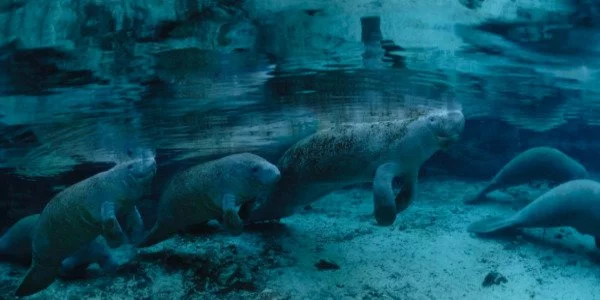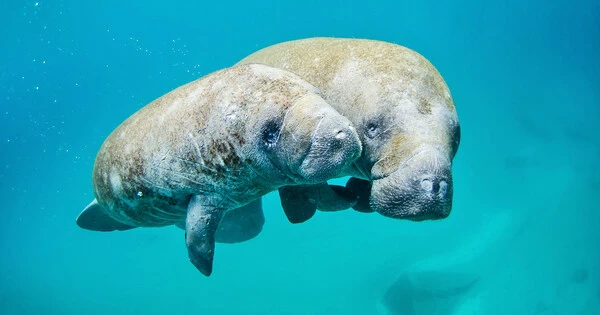While only four species of slow-moving aquatic herbivores of the order Sirenia remain on the planet, many different types of sea cows have existed for the past 47 million years. Sea cows have lived along the coasts of every continent except Antarctica, and multiple species have coexisted at times. A new article has compiled the most complete history of these strange creatures’ ancestors to date.
Manatees and dugongs are referred to as “sea cows” by zoologists, but a quick internet search may yield the more amusing moniker “floaty potatoes.” Imagine a 24,000-pound version swimming in the Bering Sea, twice the size of an elephant.
While only four species of the round, slow-moving aquatic herbivores of the order Sirenia remain on Earth — and all are considered vulnerable to extinction — fossil evidence suggests that many different kinds of sea cows lived in the past, and at times numerous species coexisted. Over their long history sea cows have lived along the coasts of every continent but Antarctica.
The earliest known fossil sea cows are about 47 million years old, and those animals lived along the northern African coasts in the proto-Mediterranean Sea. Our research discovered that this first appearance occurred approximately 11 million years after the sea cow lineage diverged from their closest living relatives, elephants.
Steven Heritage
A new paper appearing today in the open access journal PeerJ has assembled the most complete story yet of these unique creatures’ ancestry.
“The earliest known fossil sea cows are about 47 million years old, and those animals lived along the northern African coasts in the proto-Mediterranean Sea,” said co-author Steven Heritage of the Duke Lemur Center’s Museum of Natural History. “Our research discovered that this first appearance occurred approximately 11 million years after the sea cow lineage diverged from their closest living relatives, elephants.”
Elephants’ earliest fossil ancestors were also from Northern Africa and lived during the early Cenozoic period, which followed the extinction of the dinosaurs. While modern manatees and dugongs have no hind limbs and are only found in the sea, the oldest known fossil sea cows had four limbs and could walk on land.
The study compiled the most comprehensive dataset of living and fossil species ever assembled, combining genetics, anatomy, geography, and geologic ages. The researchers used time-scaled statistical models to determine the ancestry of sea cows, as well as historical biogeography models to determine the ages and directions of their migrations across the Earth’s oceans.
“Our models suggest that the direct ancestors of manatees evolved within continental South America, and the migration of manatees into the Caribbean and towards the coasts of North America was a relatively recent event,” said Erik Seiffert of the USC Keck School of Medicine and coauthor of the paper.
“In a sense, manatees are newcomers to these West Atlantic ecosystems,” Seiffert said.

For much of the past 20 million years, a large portion of northern South America was covered by fresh water wetlands — these eventually gave rise to the Amazon River system with drainage into the South Atlantic Ocean beginning only a few million years ago. Manatees from that vast marshland seem to have made their way out of South America after that time.
Around 34 million years ago, a key trans-Atlantic migration from the Eastern Hemisphere towards southern North America and the Caribbean gave rise to the common ancestor of the living sea cow species.
The age of that migration corresponds to the Eocene-Oligocene boundary, which was a time of plummeting global sea levels, a rapidly cooling climate, and widespread and severe extinctions of numerous animal species both on land and in the sea.
After that, the Eastern Hemisphere’s ancestral sea cows began to decline and eventually vanished. However, the Western Hemisphere lineage that emerged near the beginning of the Oligocene gave rise to a plethora of sea cow species that thrived and persisted for tens of millions of years, sometimes living in communities of multiple species.
The study also discovered that at least three Caribbean sea cow lineages migrated into the Pacific Ocean between 23 and 5 million years ago, prior to the connection of Central and South America.
The massive Steller’s Sea Cow, a cold-adapted species that measured up to 33 feet, was a descendant of those Pacific migrations. During the mid-1700s, European naturalists exploring the Bering Sea islands saw living Steller’s Sea Cows, but the species was hunted to extinction soon after.
According to the researchers, the greatest diversity of sea cow lineages occurred between 22 and 16 million years ago. However, over the last 9 million years, the number of lineages has plummeted, resulting in the few species that exist today.





